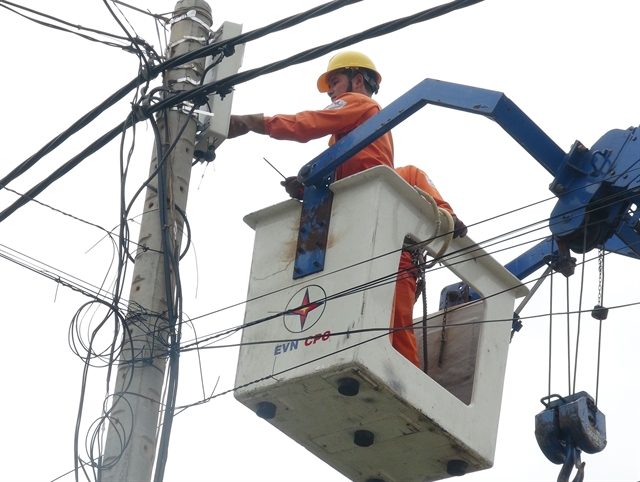Electricity sector needs accountability and transparency


*Võ Trí Thành
The electrical power industry has played a pivotal role in a country’s economic development and energy security. Since 1750, the world has experienced three industrial revolutions, and even at dawn of the Industry 4.0 today, electricity remains a necessity for production and improvement of living standards.
In terms of market structure, electrical power is a special kind of product that involves a natural monopoly (which occurs because the high cost of infrastructure limits new entries into the market). Storage is also a challenge, so electricity must be generated at the same rate at which it is consumed.
The estimation of power generation, demand and tariff is important as any changes in power prices have multidimensional impacts on the economy and society. The State’s work in this sector is needed to diminish adverse impacts and ensure the power supply.
Việt Nam’s power demand surged over the last 20 years, averaging 10 per cent growth per year. As the economy continues to expand and living conditions improve considerably, electricity consumption is predicted to keep rising in the coming years.
Big issues
The country has been facing big issues in developing energy production. The world is demanding clean energy but the cost of producing such kind of energy is still high and Việt Nam has developed support policies to encourage investors to invest in renewable energy.
Other challenges include reforms to the sector and State management to increase competitiveness, and the search for technological innovations to reduce power demand and use energy more efficiently.
Moreover, Việt Nam is developing a digital economy which requires huge amounts of power but the amount of electricity needed to digitalise the economy has not yet been calculated.
Some studies have found that Việt Nam’s power policies are not attractive enough to encourage potential investors to jump into the industry. The Government has been said to be hesitant and little confused on how best to regulate the power industry. Though the country has a national energy development plan until 2035 with the target of developing a competitive energy market, implementation has not kept pace with the roadmap.
The industry is under pressure from many sides. The tariffs must be attractive enough to draw investment but should not cause unwanted impacts on the economy and society. Price regulation must ensure macroeconomic stability, low inflation rates and support for poor households.
In Việt Nam, power tariffs have almost doubled in the last decade with seven adjustments.
Since March this year, the average retail price for power has been raised by 8.36 per cent, from VNĐ1,720 (7.49 US cents) per kWh to VNĐ1,864 (8.03 US cents), excluding value added tax. Different pricing schemes continue to be applied for households and businesses.
Although people and businesses do not want prices to increase, the change was necessary after Việt Nam Electricity (EVN), the country’s sole power distributor, reported rising production costs due to increasing prices of inputs such as coal, gas and electricity imports.
According to the Ministry of Industry and Trade, the hike could lower Việt Nam’s GDP this year by 0.22 per cent and lift the consumer price index (CPI) by 0.29 per cent, but the inflation rate by end-year will be well in line with the Government’s target of below 4 per cent.
Việt Nam’s inflation rate in 2018 was 3.54 per cent despite the electricity tariff increasing by more than 6 per cent in the end of 2017.
EVN continues to support poor households with the equivalent of 30 kWh per month. The price hike also helped raise awareness among consumers of using electricity efficiently to protect the environment.

Sector reform
The roadmap for raising electricity tariffs is necessary to remove subsidies and make sure power prices closely follow the market, but these decisions must be made transparently.
Price hikes should be understood within the broader perspective of restructuring the whole power industry. The electricity industry has a natural monopoly but some sector fragmentation in power generation and retail could lead to more competition.
The national power development strategy lays out a roadmap for competitive generation and retail markets, but implementation of these markets has not kept pace with expectations.
The reform and transparency of EVN plays an important role, but information on the operation of the State-owned group such as divestment and non-core investments has not been widely available to the public.
EVN's efforts in reducing transmission losses should be recognised. But it should review the current tariffs (the lowest rate of 50kWh/month is low compared to current living standards), the distance between each tariff, the calculation methods and support level for poor households.
This is not simply a story of increasing electricity prices but also a matter of accountability, transparency and sector reform. Việt Nam has been struggling to develop its energy industry and needs investment from many stakeholders due to a lack of State funds.
The World Bank estimates that Việt Nam needs to raise up to US$150 billion by 2030 to develop the sector. To attract private investors, raising power tariffs is not enough and the Government needs bold measures to reform the sector and possibly build an independent body to monitor and manage EVN to increase transparency and accountability. — VNS
* Võ Trí Thành is a senior economist at the Central Institute for Economic Management (CIEM) and a member of the National Financial and Monetary Policy Advisory Council. A doctorate in economics from the Australian National University, Thành mainly undertakes research and provides consultation on issues related to macroeconomic policies, trade liberalisation and international economic integration. Other areas of interest include institutional reforms and financial systems. He authors Việt Nam News’s new column, “Analyst’s Pick”. - Khánh
Tags:





